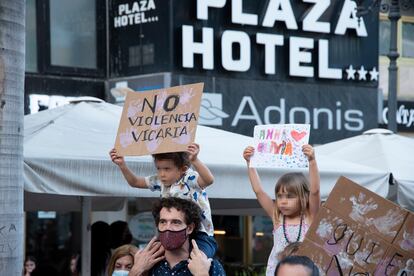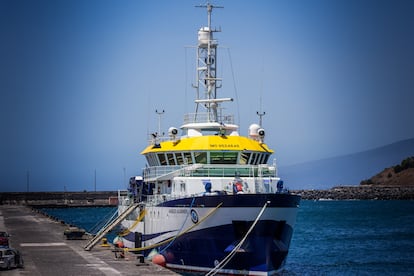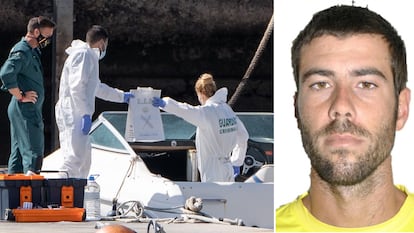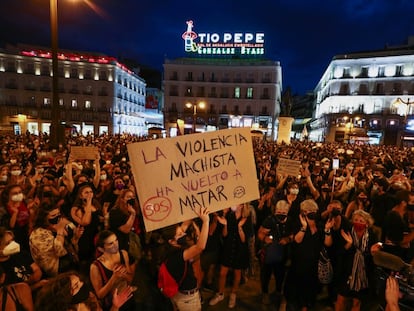Anna and Olivia killer: the man who wanted to cause his ex ‘the greatest imaginable pain’
A judge’s report provides a minute-by-minute account of the steps taken by Tomás Gimeno on the day he murdered his own children in Tenerife and dumped their bodies in the sea

Tomás Gimeno, 37, killed his daughters Anna and Olivia, aged one and six, in his house on April 27. He then wrapped them up in towels, put them into trash bags and then into sports bags, before loading them into the trunk of his white Audi A3. That’s according to the court investigation into the killings, which have left Spain shocked and stunned after the body of Olivia was discovered at the bottom of the sea off the coast of the Canary Island of Tenerife last week. The search for Anna continues.
According to the court documents, which were made public this weekend, Gimeno then drove his car to his parents’ house in Santa Cruz de Tenerife. There, without anyone seeing him, he left behind his dog, two credit cards with their pin numbers, and two sets of keys for the last car that he had purchased – a black Alfa Romeo that he had protected carefully with a car cover.
From his parents’ house, he drove to the port, setting sail in his boat. He stopped the vessel in an area that he knew had deep water, and toward 10.30pm he threw the sports bags with the bodies of his daughters into the water. The bags were weighed down with heavy objects and were also attached to his boat’s anchor. At that moment he called his former partner and the mother of the children, Beatriz Zimmermann, who was at a Civil Guard station reporting the disappearance of Olivia and Anna.

The judicial document, which is based on police investigations into the crime, states that Gimeno “was trying to cause the greatest pain imaginable to his ex-partner.” To do so, the text adds, he “sought to create uncertainty as to the destination of his daughters by hiding their bodies in places [...] where he thought that they would never be found, all of this after announcing to his ex-wife, as well as his relatives, that he was leaving with Olivia and Anna and that they would never be seen again.”
Tomás Gimeno and Beatriz Zimmermann had been dating since they were teenagers. They separated last year, during the pandemic. Since then, the court document states, he would direct “offensive” comments at her, criticizing her for having rebuilt her life. The mother of Olivia and Anna had a new partner, a 60-year-old man of Belgian origin. She had also moved to what had been her family home in Radazul, a few kilometers from Santa Cruz de Tenerife. A nearby resident said that she had seen her a week before the girls disappeared on April 27. “I saw her happy,” she said. “Hopeful. She told me she was very happy to have returned.”
On the day of the disappearance, Gimeno told Zimmerman that he wanted to spend the afternoon with his daughters and so arranged to collect Anna at 5pm. He then went to collect Olivia from a German school camp. Gimeno covered up his Alfa Romeo car, something that suggests he wasn’t improvising and was following a plan. He also handed the director of the school center, with whom he had a relationship, a pencil case wrapped in tape, telling her not to open it until 11pm and to call him at that time. Then he left with his daughters. The woman ignored his instructions, however, and at around 5.20pm she opened the pencil case to find €6,200 in cash inside and a goodbye letter.

Police and Civil Guard investigators believe, however, that the plan was not put together many days previously, as he only used items and elements that were readily at his reach.
He then drove to his parents’ house, leaving Anna in their care while Olivia took a tennis class. During that time, Gimeno went to the port to check that his boat, named Esquilón, was working correctly. He returned to the tennis club to collect Olivia, and went to his parents’ house. At 7.30pm he went to his own house, located by Igueste mountain in Candelaria. Shortly before killing his daughters, Gimeno sent a voice message to his ex-partner, at 7.50pm. In it, Olivia said to her mother that her father wanted her to come by the house at 9pm to collect some paintings. But when Zimmermann arrived that night, there was no one there.
In a spot with a depth of 1,000 meters, three nautical miles off the city of Santa Cruz, he dumped the bodies of his daughters with the intention that they never be found by their mother.
The city of Santa Cruz de Tenerife, which has been left shocked by the crime, is asking itself who Tomás Gimeno was. Someone who knew him, and who opted not to give their name, said that he was “showy.” He loved playing padel tennis, liked fast cars and would return jokes with a more annoying prank. “He drove really well, and would go at 260 or 300 kilometers an hour,” the source explained. “He wouldn’t stop until the person with him said, ‘Christ, that’s enough’.”
Gimeno came from a well-off family in Santa Cruz de Tenerife, and had worked all his life in his father’s businesses. His dad, also named Tomás Gimeno, was also a fan of fast cars, and was a one-time rally driver. He owns agricultural land and a golf club.

At 10.40pm, according to the court documents, and after speaking to his ex-partner, Gimeno was still on the boat, now without an anchor, and after having dumped their bodies into the sea. At that point his cellphone battery ran out, so he returned to the port to get a charger.
At 11.15pm, he was intercepted by a Civil Guard patrol, which instructed him to dock immediately given that it was past the local coronavirus curfew. He was fined for breaking the restriction. Gimeno told them that he was going to dock and then go home and sleep, but then he told them he had changed his mind and that he would spend the night in the boat. The patrol boat left headed north, and would not return until 2.30am. It found nothing of note on the scene.
Gimeno asked the port security guard for a mobile charger, but it wasn’t compatible with his phone. He then got in his Audi A3 and purchased one at a gas station, along with a pack of cigarettes and a bottle of water. He charged the mobile in the security guard’s office, asking the man if he knew where the Civil Guard patrol had gone. At 12.27am he set sail in his boat again. No one has seen him since then.
His phone was operational once more at 12.41am. At 1.30am he spoke to Zimmermann, and they discussed their relationship. He insisted that he was going far away and that she would not see her daughters again. At 2.11am he called his current partner, saying a “definitive goodbye,” according to the court documents. He told his father that “he was really sorry, but that he needed this,” the text states. He gave some of his friends possessions such as his motorbike or boat as gifts, and to others he sent messages such as: “I’m going to be good, I’m going to be better.”
At 5.35pm on April 28, exactly 24 hours after he collected his children, his boat was found drifting. The car seat belonging to the younger of the two sisters was also discovered floating in the sea. After 44 days with no answers and so much uncertainty, on Thursday the body of Olivia was found in a bag at a depth of a thousand meters. Next to it was another bag – it was empty.
After examining the facts of the case, the judge in charge has decided to to transfer it to the gender violence court in Santa Cruz de Tenerife. Meanwhile, the Ángeles Alvariño vessel is still searching the sea bed for Anna’s body, and presumably that of Gimeno too. On Saturday the ship had to dock in the port due to a malfunction. But it is expected to restart the search mission today, Monday.
On Friday, around 1,000 people – most of them women – came out to protest against gender violence in Candelaria square, in the heart of Santa Cruz de Tenerife. One young girl was holding a sign that read: “Stop killing us.”
English version by Simon Hunter.
Tu suscripción se está usando en otro dispositivo
¿Quieres añadir otro usuario a tu suscripción?
Si continúas leyendo en este dispositivo, no se podrá leer en el otro.
FlechaTu suscripción se está usando en otro dispositivo y solo puedes acceder a EL PAÍS desde un dispositivo a la vez.
Si quieres compartir tu cuenta, cambia tu suscripción a la modalidad Premium, así podrás añadir otro usuario. Cada uno accederá con su propia cuenta de email, lo que os permitirá personalizar vuestra experiencia en EL PAÍS.
¿Tienes una suscripción de empresa? Accede aquí para contratar más cuentas.
En el caso de no saber quién está usando tu cuenta, te recomendamos cambiar tu contraseña aquí.
Si decides continuar compartiendo tu cuenta, este mensaje se mostrará en tu dispositivo y en el de la otra persona que está usando tu cuenta de forma indefinida, afectando a tu experiencia de lectura. Puedes consultar aquí los términos y condiciones de la suscripción digital.
More information
Últimas noticias
Most viewed
- Sinaloa Cartel war is taking its toll on Los Chapitos
- Oona Chaplin: ‘I told James Cameron that I was living in a treehouse and starting a permaculture project with a friend’
- Reinhard Genzel, Nobel laureate in physics: ‘One-minute videos will never give you the truth’
- Why the price of coffee has skyrocketed: from Brazilian plantations to specialty coffee houses
- Silver prices are going crazy: This is what’s fueling the rally










































